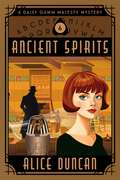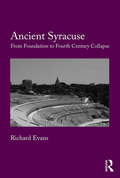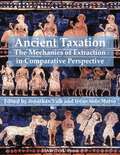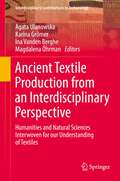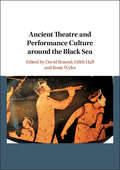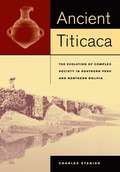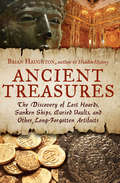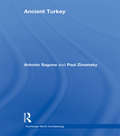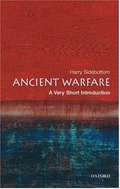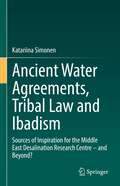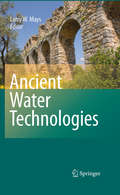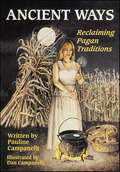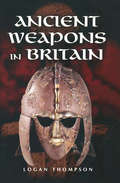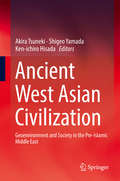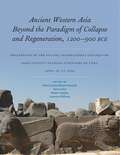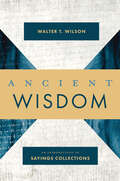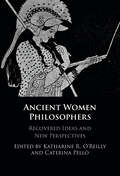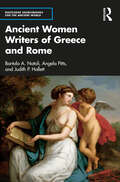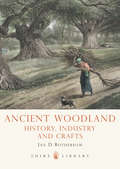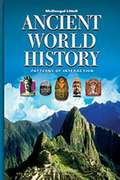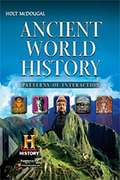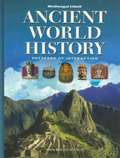- Table View
- List View
Ancient Spirits (Daisy Gumm Majesty Mystery #6)
by Alice DuncanDaisy Gumm Majesty has put her Ouija board aside, following her husband's passing. Only when Mrs. Pinkerton's daughter is arrested does Daisy pick it up again, and is immediately rewarded with useful information.Mrs. P is so delighted she pays Daisy an enormous amount of money, which comes in handy when Mrs. P's son (and Daisy's best friend) insists Daisy accompany him on a trip to Egypt.Arriving in Cairo, Daisy makes an innocent purchase of a unique canopic jar and lands in the middle of a smuggling ring.Convinced Daisy is in trouble, Sam hies himself to Egypt where he joins the spiritualist/sleuth in an adventure that will last a lifetime.REVIEWS:"Well plotted with a band of whimsical characters and genuine humor... as comforting as a warm mug of cocoa on a blustery day." ~Diane Morasco, RT Book Reviews"Cozy fans will find [Daisy's] simple, sweet, budding relationship with Sam refreshingly free of artifice." ~Publishers WeeklyTHE DAISY GUMM MAJESTY MYSTERIES, in series orderStrong SpiritsFine SpiritsHigh SpiritsHungry SpiritsGenteel SpiritsAncient SpiritsDark SpiritsSpirits OnstageUnsettled SpiritsBruised SpiritsSpirits UnitedSpirits UnearthedShaken Spirits
Ancient Syracuse: From Foundation to Fourth Century Collapse
by Richard EvansSyracuse possesses a unique place in the history of the ancient Mediterranean because of its contribution to Greek culture and political thought and practice. Even in the first century BC Cicero could still declare ’You have often heard that of all the Greek cities Syracuse is the greatest and most beautiful.’ Sicily’s strategic location in the Mediterranean brought the city prosperity and power, placing it in the first rank of states in the ancient world. The history and governance of the city were recorded from the fifth century BC and the volume of literary sources comes close to matching the records of Athens or Rome. Combining literary and material evidence this monograph traces the history of Syracuse, offering new arguments about the date of the city’s foundation, and continues through the fifth century when, as a democracy, Syracuse’s military strength grew to equal that of Athens or Sparta, surpassing them in the early fourth century under the tyrant Dionysius I. From ca. 350 BC, however, the city’s fortunes declined as the state was wracked with civil strife as the tyranny lost control. The result was a collapse so serious that the city faced complete and imminent destruction.
Ancient Taxation: The Mechanics of Extraction in Comparative Perspective (ISAW Monographs #11)
by Jonathan Valk and Irene Soto MarínA collection of studies that explores the extractive systems of eleven ancient states and societies from across the ancient worldAncient Taxation is a collection of studies that explores the extractive systems of eleven ancient states and societies from across the ancient world, ranging from Bronze Age China to Anglo-Saxon Britain. The contributors discuss the inherent challenges of taxation in predominantly agro-pastoral societies, including basic tax strategy (e.g., taxing goods vs. labor, in-kind vs. money taxes, etc.); the mechanics of assessment and collection; and the politics of negotiating the cooperation of social, economic, and political élites and other important social groups. In assembling a broad range of studies, this book sheds new light on the commonalities and differences between ancient taxation systems, and so on the broader fiscal and institutional practices of antiquity. It also provides new impetus for further comparative research into extractive practices across ancient societies and between antiquity and recent historical periods.The book will be of interest to those studying ancient social and economic history, the history of social organization, and the history of ancient Greece and Rome, Egypt, the Ancient Near East, or ancient China.
Ancient Textile Production from an Interdisciplinary Perspective: Humanities and Natural Sciences Interwoven for our Understanding of Textiles (Interdisciplinary Contributions to Archaeology)
by Karina Grömer Agata Ulanowska Ina Vanden Berghe Magdalena ÖhrmanThe diverse developments in textile research of the last decade, along with the increased recognition of the importance of textile studies in adjacent fields, now merit a dedicated, full-length publication entitled “Ancient Textile Production from an Interdisciplinary Perspective: Humanities and Natural Sciences Interwoven for our Understanding of Textiles”. With this volume, the authors and the editors wish to illustrate to the current impact of textile archaeology on the scholarly perception of the past (not limited to archaeology alone). The volume presents new insights into the consumption, meaning, use and re-use of textiles and dyes, all of which are topics of growing importance in textile research. As indicated by the title, we demonstrate the continued importance of interdisciplinarity by showcasing several ‘interwoven’ approaches to environmental and archaeological remains, textual and iconographic sources, archaeological experiments and ethnographic data, from a large area covering Europe and the Mediterranean, Near East, Africa and Asia. The chronological span is deliberately wide, including materials dating from c. 6th millennium BCE to c. mid-14th century CE. The volume is organised in four parts that aim to reflect the main areas of the textile research in 2020. After the two introductory chapters (Part I: About this Volume and Textile Research in 2020), follow two chapters referring to dyes and dyeing technology in which analytical and material-based studies are linked to contextual sources (Part II: Interdisciplinarity of Colour: Dye Analyses and Dyeing Technologies). The six chapters of Part III: Interdisciplinary Approaches to Textile Tools discuss textiles and textile production starting from the analyses of tools, whether functional or as representative of technological developments or user identity. Archaeological and cultural contexts as well as textile traditions are the main topics of the six chapters in Part IV: Traditions and Contexts: Fibres, Fabrics, Techniques, Uses and Meanings. The two final chapters in Part V: Digital Tools refer to the use of digital tools in textile research, presenting two different case studies.
Ancient Theatre and Performance Culture Around the Black Sea
by Edith Hall David Braund Rosie WylesThis is the first study of ancient theatre and performance around the coasts of the Black Sea. It brings together key specialists around the region with well-established international scholars on theatre and the Black Sea, from a wide range of disciplines, especially archaeology, drama and history. In that way the wealth of material found around these great coasts is brought together with the best methodology in all fields of study. This landmark book broadens the whole concept and range of theatre outside Athens. It shows ways in which the colonial world of the Black Sea may be compared importantly with Southern Italy and Sicily in terms of theatre and performance. At the same time, it shows too how the Black Sea world itself can be better understood through a focus on the development of theatre and performance there, both among Greeks and among their local neighbours.
Ancient Titicaca: The Evolution of Complex Society in Southern Peru and Northern Bolivia
by Charles StanishA broad, up-to-date synthesis of 4000 years of prehistoric social and political organization in the Lake Titicaca region of southern Peru and Bolivia, from the time the region was first settled (about 2000 BC) to the coming of the Spaniards in the 1530s.
Ancient Treasures: The Discovery of Lost Hoards, Sunken Ships, Buried Vaults, and Other Long-Forgotten Artifacts
by Brian HaughtonWhy are so many people fascinated by treasure? Is it purely a desire for wealth, or is it also the romantic appeal of tales of lost ancient artifacts?It is certainly true that the stories behind the loss and recovery of a number of ancient treasures read like edge-of-the-seat fiction, somewhere between Indiana Jones and James Bond.In Ancient Treasures, you will read fascinating stories of lost hoards, looted archaeological artifacts, and sunken treasures, including:The Sevso Treasure, a hoard of large silver vessels from the late Roman Empireestimated to be worth $200 millionlooted in the 1970s and sold on the black market.The Amber Room, a complete chamber decoration of amber panels backed with gold leaf and mirrors, stolen by the Nazis in 1941 and brought to the castle at Knigsberg in Russia, from which it disappeared.The fabulous wealth of Roman and Viking hoards buried in the ground for safekeeping, only to be unearthed centuries later by humble metal detectorists.The wrecks of the Spanish treasure fleets, whose New World plunder has been the target of elaborate salvage attempts by modern treasure hunters
Ancient Turkey (Routledge World Archaeology)
by Antonio Sagona Paul ZimanskyStudents of antiquity often see ancient Turkey as a bewildering array of cultural complexes. Ancient Turkey brings together in a coherent account the diverse and often fragmented evidence, both archaeological and textual, that forms the basis of our knowledge of the development of Anatolia from the earliest arrivals to the end of the Iron Age. Much new material has recently been excavated and unlike Greece, Mesopotamia, and its other neighbours, Turkey has been poorly served in terms of comprehensive, up-to-date and accessible discussions of its ancient past. Ancient Turkey is a much needed resource for students and scholars, providing an up-to-date account of the widespread and extensive archaeological activity in Turkey. Covering the entire span before the Classical period, fully illustrated with over 160 images and written in lively prose, this text will be enjoyed by anyone interested in the archaeology and early history of Turkey and the ancient Near East.
Ancient Warfare: A Very Short Introduction
by Harry SidebottomGreek and Roman warfare was unlike that of any other culture before or since. The key difference is often held to be that the Greeks and Romans practiced a "Western Way of War," in which the aim is an open, decisive battle--won by courage instilled, in part, by discipline. Here, Harry Sidebottom looks at how this Western Way of War was constructed and maintained by the Greeks and Romans and why this concept is so prevalent today. All aspects of ancient warfare are thoroughly examined--from philosophy and strategy to the technical skills needed to fight. Sidebottom examines war in the wider context, showing how wars were able to shape classical society, and how an individual's identity was sometimes constructed by war, as in the case of the Christian soldier fighting in God's name. He also explores the ways in which ancient society thought about conflict: Can a war be just? Why was siege warfare particularly bloody? What role did divine intervention play in the outcome of a battle? Taking fascinating examples from the Iliad, Tacitus, and the Persian Wars, Sidebottom uses arresting anecdotes and striking visual images to show that any understanding of ancient war is an ongoing process of interpretation.
Ancient Water Agreements, Tribal Law and Ibadism: Sources of Inspiration for the Middle East Desalination Research Centre – and Beyond?
by Katariina SimonenThis book traces the development of Oman's inclusive agreements and highlights their importance for international negotiations, dealing with issues most relevant to humanity's own survival today, nuclear weapons or climate change.In Oman, a historical seafaring nation on the south-eastern corner of the Arabian Peninsula, a culture of agreement that accommodates the interests of everyone has developed around the division of scarce water resources.Life in the arid inland of the Omani Hajar mountains would not have been possible without water. Irrigation channel (falaj) construction is extremely old and skilful therein. Local practices evolved around the division of water and land on the basis of fairness. The community would be best served by inclusion and the avoidance of conflict.A specific Islamic school called Ibadi arrived at Oman early on in the eighth century. Ibadi scholars conserved local practices. Consultation and mediation by sheikhs and the religious leader, Imam, became the law of the land. The Omanis were known as the People of Consultation, Ahl Al Shura. In time, the practice of inclusive agreements would extend far beyond the village level, affecting Oman´s foreign policy under Sultan Qaboos. Oman´s water diplomacy succeeded in uniting the contestants of the Middle East Peace Process in the 1990s to work together on common problems of water desalination.
Ancient Water Technologies
by L. MaysThere is no more fundamental resource than water. The basis of all life, water is fast becoming a key issue in today's world, as well as a source of conflict. This fascinating book, which sets out many of the ingenious methods by which ancient societies gathered, transported and stored water, is a timely publication as overextraction and profligacy threaten the existence of aquifers and watercourses that have supplied our needs for millennia. It provides an overview of the water technologies developed by a number of ancient civilizations, from those of Mesopotamia and the Indus valley to later societies such as the Mycenaeans, Minoans, Persians, and the ancient Egyptians. Of course, no book on ancient water technologies would be complete without discussing the engineering feats of the Romans and Greeks, yet as well as covering these key civilizations, it also examines how ancient American societies from the Hohokams to the Mayans and Incas husbanded their water supplies. This unusually wide-ranging text could offer today's parched world some solutions to the impending crisis in our water supply. "This book provides valuable insights into the water technologies developed in ancient civilizations which are the underpinning of modern achievements in water engineering and management practices. It is the best proof that "the past is the key for the future." Andreas N. Angelakis, Hellenic Water Supply and Sewerage Systems Association, Greece "This book makes a fundamental contribution to what will become the most important challenge of our civilization facing the global crisis: the problem of water. Ancient Water Technologies provides a complete panorama of how ancient societies confronted themselves with the management of water. The role of this volume is to provide, for the first time on this issue, an extensive historical and scientific reconstruction and an indication of how traditional knowledge may be employed to ensure a sustainable future for all." Pietro Laureano, UNESCO expert for ecosystems at risk, Director of IPOGEA-Institute of Traditional Knowledge, Italy
Ancient Ways: Reclaiming the Pagan Tradition
by Pauline CampanelliPauline and Dan Campanelli's classic companion to Wheel of the Year is back for a new generation of readers to enjoyCelebrate the seasons of the year according to the ancient Pagan traditions. Ancient Ways shows how to prepare for and conduct the Sabbat rites, and helps you harness the magickal energy for weeks afterward. The wealth of seasonal rituals and charms within are drawn from ancient sources but are easily performed with readily available materials.Learn how to look into your previous lives at Yule. At Beltane, discover the places where you are most likely to see faeries. Make special jewelry to wear for your Lammas celebrations. For the special animals in your life, paint a charm of protection at Midsummer.Most Pagans feel that the Sabbat rituals are all too brief and wish for the magick to continue. Ancient Ways can help you reclaim your own traditions and heighten the feeling of magick all year long.Praise: "A delightful, joyous guide to celebrating the seasons and festivals with homespun magic." —Scott Cunningham, author of Cunningham's Encyclopedia of Magical Herbs "A delightful book that beautifully complements the authors' Wheel of the Year." —Ray Buckland, author of Practical Candleburning Rituals
Ancient Weapons in Britain
by Logan ThompsonA groundbreaking study of the weaponry used in combat thousands of years ago. Few accounts of ancient warfare have looked at how the weapons were made and how they were actually used in combat. Logan Thompson's pioneering survey traces the evolution of weapons in Britain across three thousand years, from the Bronze Age to the Battle of Hastings in 1066. Insights gained from painstaking practical research and technical analysis shed new light on the materials used, the processes of manufacture, the development of the weapons, and their effectiveness. His account features new information about the weapons themselves and their origin and design—as well as a fascinating new perspective on the practice of early warfare.
Ancient West Asian Civilization: Geoenvironment and Society in the Pre-Islamic Middle East
by Akira Tsuneki Shigeo Yamada Ken-Ichiro HisadaThis book explores aspects of the ancient civilization in West Asia, which has had a great impact on modern human society--agriculture, metallurgy, cities, writing, regional states, and monotheism, all of which appeared first in West Asia during the tenth to first millennia BC. The editors specifically use the term "West Asia" since the "Middle East" is seen as an Eurocentric term. By using this term, the book hopes to mitigate potential bias (i. e. historical and Western) by using a pure geographical term. However, the "West Asia" region is identical to that of the narrower "Middle East," which encompasses modern Iran and Turkey from east to west and Turkey and the Arabian Peninsula from north to south. This volume assembles research from different disciplines, such as the natural sciences, archaeology and philology/linguistics, in order to tackle the question of which circumstances and processes these significant cultural phenomena occurred in West Asia. Scrutinizing subjects such as the relations between climate, geology and human activities, the origins of wheat cultivation and animal domestication, the development of metallurgy, the birth of urbanization and writing, ancient religious traditions, as well as the treatment of cultural heritage, the book undertakes a comprehensive analysis of West Asian Civilization that provided the common background to cultures in various areas of the globe, including Europe and Asia. These contributions will attempt to demonstrate a fresh vision which emphasizes the common cultural origin between Europe and West Asia, standing in opposition to the global antagonism symbolized by the theory of "Clash of Civilizations. "
Ancient Western Asia Beyond the Paradigm of Collapse and Regeneration: Proceedings of the NYU-PSL International Colloquium, Paris Institut National d’Histoire de l’Art, April 16–17, 2019 (ISAW Monographs)
by Maria Grazia Masetti-Rouault, Ilaria Calini, Robert Hawley, and Lorenzo d’AlfonsoNew results and interpretations challenging the notion of a uniform, macroregional collapse throughout the Late Bronze Age Eastern MediterraneanAncient Western Asia Beyond the Paradigm of Collapse and Regeneration (1200–900 BCE) presents select essays originating in a two-year research collaboration between New York University and Paris Sciences et Lettres. The contributions here offer new results and interpretations of the processes and outcomes of the transition from the Late Bronze Age to the Iron Age in three broad regions: Anatolia, northern Mesopotamia, and the Levant. Together, these challenge the notion of a uniform, macroregional collapse throughout the Eastern Mediterranean, followed by the regeneration of political powers. Current research on newly discovered or reinterpreted textual and material evidence from Western Asia instead suggests that this transition was characterized by a diversity of local responses emerging from diverse environmental settings and culture complexes, as evident in the case studies collected here in history, archaeology, and art history. The editors avoid particularism by adopting a regional organization, with the aim of identifying and tracing similar processes and outcomes emerging locally across the three regions. Ultimately, this volume reimagines the Late Bronze–Iron Age transition as the emergence of a set of recursive processes and outcomes nested firmly in the local cultural interactions of western Asia before the beginning of the new, unifying era of Assyrian imperialism.
Ancient Wisdom: An Introduction to Sayings Collections (Wisdom Literature From The Ancient World Ser. #1)
by Walter T. WilsonThis book surveys and analyzes twenty-seven major collections of wisdom sayings from antiquity, including texts from ancient Egypt, the ancient Near East, ancient Israel and early Judaism, early Christianity, and the Greco-Roman world. Through the diversity of these selections, readers are exposed to wisdom literature from a wide array of historical, cultural, and linguistic settings, which unfolds into a larger understanding of how different ancient peoples articulated a gnomic understanding of life. Throughout this useful guide, Walter Wilson keeps a constant eye on the relation of the wisdom texts to the worlds from which they emerged—paying close attention to each text&’s distinctive thematic profile and how its moral agenda was mapped onto the reader&’s social landscape. Where appropriate, he discusses affinities between the different collections and draws conclusions about ancient wisdom literature as a genre. For further study, each entry includes a short bibliography directing the reader to an up-to-date translation of the collection in question and other relevant secondary texts, making this an ideal starting point for anyone studying wisdom literature of the ancient world.
Ancient Women Philosophers: Recovered Ideas and New Perspectives
by Caterina Pellò Katharine R. O’ReillyDespite the common misconception that ancient philosophy was the domain of male thinkers, sources confirm that ancient women engaged in philosophical activity. Bringing together a collection of essays on ancient women thinkers, with special focus on their ideas and contributions to the history of philosophy, this volume is about the earliest women philosophers, their breakthroughs, and the methods we can use to excavate them. The essays survey the methodological strategies we can use to approach the surviving evidence, retrieve the largely unresearched thought and the original ideas of ancient women philosophers, and carve out a space for them in the canon. The broad focus includes women thinkers in ancient Indian, Chinese, and Arabic philosophy as well as in the Greek and Roman philosophical traditions. The volume will be valuable for a wide range of researchers, teachers, and students of ancient philosophy.
Ancient Women Writers of Greece and Rome (Routledge Sourcebooks for the Ancient World)
by Judith P. Hallett Bartolo A. Natoli Angela PittsAncient Women Writers of Greece and Rome features the extant writings of major female authors from the Greco-Roman world, brought together for the first time in a single volume, in both their original languages and translated into English with accompanying commentaries. The most cost-effective and comprehensive way to study the women writers of Greece and Rome, this book provides original texts, accessible text-commentaries, and detailed English translations of the works of ancient female poets and authors such as Sappho and Sulpicia. It takes a student-focused approach, discussing texts alongside new and original English translations and highlighting the rich, diverse scholarship on ancient women writers to specialists and non-specialists alike. The perspectives of women in the ancient world are still relevant and of interest today, as issues of gender and racial (in)equality remain ever-present in modern society. Ancient Women Writers of Greece and Rome provides a valuable teaching tool for students of Greek, Latin, and Classical Studies, as well as those interested in ancient literature, history, and gender studies who do not have proficiency in Greek or Latin.
Ancient Woodland: History, Industry and Crafts
by Ian RotherhamCONTRARY TO POPULAR BELIEF, Britain's ancient woodlands are not 'wildwoods', or even remnants of 'wildwood'. These truly cultural landscapes mix nature and human history, woven as uniquely rich tapestries of ecology and history. The story of the woods is there to be 'read' if you have time, enthusiasm, and this book, which will take you from prehistory to the present day.
Ancient World History: Patterns of Interaction
by Larry S. Krieger Roger B. Beck Linda Black Phillip C. Naylor Dahia Ibo ShabakaNIMAC-sourced textbook
Ancient World History: Patterns of Interaction
by Larry S. Krieger Roger B. Beck Linda Black Phillip C. Naylor Dahia Ibo ShabakaMcDougal Littell World History. Ancient World History: Patterns of Interaction: Student Edition, Grades 9-12, 2007.
Ancient World History: Patterns of Interaction
by Larry S. Krieger Roger B. Beck Linda BlackNIMAC-sourced textbook
Ancient World History: Patterns of Interaction
by McDougal LittellThe text in the 'Ancient World History: Patterns of Interaction' covers topics on: Beginnings of Civilization; New Directions in Government and Society; An Age of Exchange and Encounter; Connecting Hemispheres; and Absolutism to Revolution.
Ancient World: Adventures in Time and Place
by James A. Banks Walter C. Parker Gloria Ladson-Billings Barry K. Beyer Gloria Contreras Jean Craven Mary A. McFarlandAncient World: Adventures in Time and Place has 15 chapters, each with two or more lessons. There are also many special features for you to study and enjoy. The unit lessons cover: Understanding the Ancient World, Dawn of Civilization, Mesopotamia and Africa, India, China, and the Americas, Ancient Israel and Greece, and Rome.
Ancient World: Adventures in Time and Place
by The Editors at Mc Graw HillCalifornia proofread textbook for sixth grade. Investigates the history of the ancient world.
